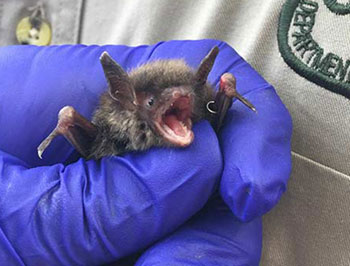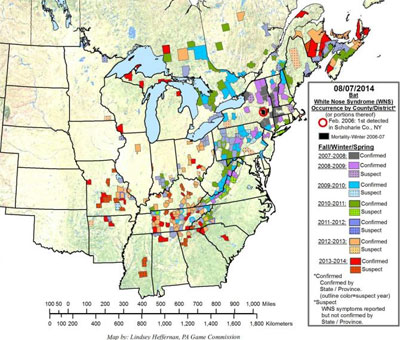by Rona Fried
For those of us who care deeply about wildlife and appreciate the incredible services bats provide – eating millions of mosquitoes every night, for example – it’s FANTASTIC news that scientists may have found a cure for White-Nose Syndrome, which has been devastating bat populations across much of the US.
Scientists and environmentalists gathered on the evening of May 19 outside the Mark Twain Cave Complex in Hannibal, Missouri. They released the first 75 bats back into the wild after being successfully treated for the deadly White-Nose Syndrome (WNS).
One of the brown bats before being released:

In 2012, Dr. Christopher Cornelison and colleagues at Georgia State University found that a common North America bacteria could inhibit growth of some fungi. Since then, researchers have been experimenting in the lab and this past winter they conducted field trials in Missouri and Kentucky caves.
The bats released all had White-Nose Syndrome, and were successfully treated with a common bacterium that releases Volatile Organic Compounds with anti-fungal properties.
"While more research is needed before we know if our current discovery in an effective and environmentally safe treatment for White-Nose Syndrome, we are very encouraged," says Michael Rains, a biologist with the US Forest Service, which has been collaborating with the researchers.
The effort has been tremendous, involving numerous federal and state environmental agencies that contribute funds and staff to survey caves for the fungus. Foundations are contributing critical funding, as are Bat Conservation International, The Nature Conservancy, and the US Forest Service.
Last year, biologists found evidence that the fungus might run its course on its own, but since bats reproduce very slowly, that could take too long to save them.
Bats and White-Nose
Bats are critical to the health of natural ecosystems and globally play an essential role in pollination, tropical reforestation and pest management.
White-Nose invades the nose, mouth and wings of bats during hibernation, when bats’ immune systems are largely shut down. Research indicates the fungus may lead to dehydration, causing them to wake up and burn precious fat reserves trying unsuccessfully to find insects to eat during the winter. They die from starvation. Up to 100% of bats die in an infected cave.
Since the cold-loving fungus arrived from Europe about 10 years ago, over 5.7 million native bats have died in the eastern half of the US and Canada, and it is spreading west.
Where White-Nose is found:

Read this great story about how scientists discovered the bacteria that works against White-Nose:
